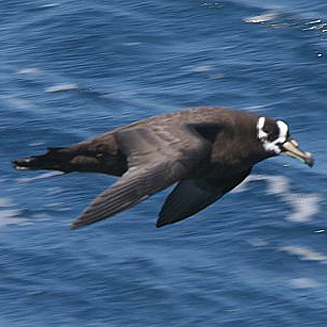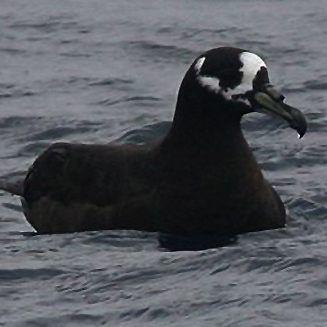|
Procellaria conspicillata
(Spectacled petrel)
Brilbassiaan [Afrikaans]; Pétrel à lunettes [French];
Painho-de-óculos [Portuguese]
Life
> Eukaryotes >
Opisthokonta
> Metazoa (animals) >
Bilateria >
Deuterostomia > Chordata >
Craniata > Vertebrata (vertebrates) > Gnathostomata (jawed
vertebrates) > Teleostomi (teleost fish) > Osteichthyes (bony fish) > Class:
Sarcopterygii (lobe-finned
fish) > Stegocephalia (terrestrial
vertebrates) > Tetrapoda
(four-legged vertebrates) > Reptiliomorpha > Amniota >
Reptilia (reptiles) >
Romeriida > Diapsida > Archosauromorpha > Archosauria >
Dinosauria
(dinosaurs) > Saurischia > Theropoda (bipedal predatory dinosaurs) >
Coelurosauria > Maniraptora > Aves
(birds) > Order: Ciconiiformes
> Family: Procellariidae
 |
 |
| Spectacled petrel, offshore from Cape Town, South Africa. [photo
Trevor Hardaker ©] |
Spectacled petrel, offshore from Cape Town, South Africa. [photo Trevor Hardaker ©] |
Distribution and habitat
Only breeds on Inaccessible Island, Tristan da Cunha group,
after which it disperse across the South Atlantic Ocean. mainly between 25-41°
South. It is scarce in southern African waters, occurring along off the west
coast from northern Namibia to the area off Cape Town, Western Cape, with an
isolated record off KwaZulu-Natal.
Movements and migrations
Little known, as there are observations of it
being most common in both summer and winter; the former is more
likely, since its numbers peak off south-eastern South America in
summer. Adults are usually present at their breeding colony from
September-March, when the chicks fledge.
Food
It mainly eats fishery discards and offal, squid, fish and
crustaceans, doing most of its foraging by grabbing prey prey from the surface
of the water or diving to slightly greater depths.
Threats
Critically endangered, with a breeding population of
just 3000-4000 pairs and a total global population of roughly 10 000
individuals. Approximately 750 birds are killed annually on longlines off
Brazil, with more deaths in southern African waters, which has largely caused
the massive decrease in its population numbers. Introduced predators uprooted a
colony on Amsterdam Island, Indian Ocean, but thankfully its remaining
Inaccessible Island colony is in a better situation, as the introduced pigs have
been removed.
References
-
Hockey PAR, Dean WRJ and Ryan PG 2005. Roberts
- Birds of southern Africa, VIIth ed. The Trustees of the John Voelcker
Bird Book Fund, Cape Town.
|
